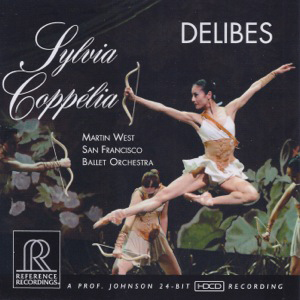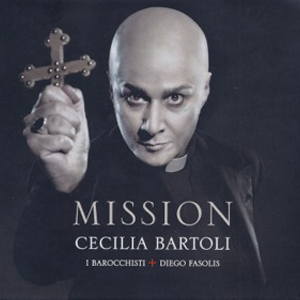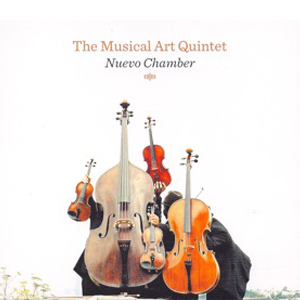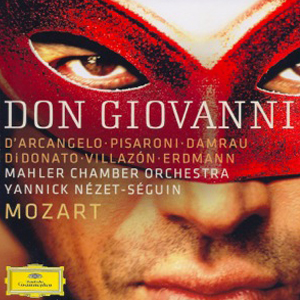Delibes: Sylvia/Coppelia “San Francisco Ballet Orchestra, Martin West” Reference Recordings
- Performance:

- Sound:


There are at least three compelling reasons to buy this recording. The music, suites drawn from Léo Delibes’ complete scores for the ballets Sylvia (first produced at Théâtre de l’Opéra, Paris, in 1876) and Coppélia (first produced at Théâtre Impérial de l’Opéra, Paris, in 1870), is lively, colorful, and filled with charm. Often relegated to a secondary role at the ballet, with some of its glories compressed into the pit as dancers prance and pirouette above, it really comes into its own when allowed to parade on its own two feet.
True, Sylvia and Coppélia are exactly the kind of fluffy divertissement that have left many a youth and elder clamoring for rock ‘n roll and heavy metal, and convinced many an Occupier that ballet is indeed for the 1% who can afford to retreat to the comfort of their Napa, Atherton, Belvedere, and Pacific Heights palaces and fantasize their own private universes of fauns, dryads, shepherds, nymphs, and mechanical dolls. But for those who can accept that music such as this served as an oft-welcome antidote to the Franco-Prussian War, and who have room in their life for its charms, Sylvia and Coppélia offer one irresistibly gay tune after another.
Second, Martin West and the San Francisco Ballet Orchestra do a bang up job. Comparison with two classic Mercury Living Presence renditions of the complete scores – Anatole Fistoulari’s Sylvia with the London Symphony Orchestra, and Antal Doráti’s Coppélia with the Minneapolis Symphony Orchestra – find West’s tempos broader in some key movements, and hence more conducive to listening without visuals. As for the sound of the instruments on those classic recordings, one listen to the harsh violins in Fistoulari’s Sylvia will send you running to San Francisco’s silken strings.
Which leads us to the third reason for hitting the “buy” tab. This latest release from Bay Area’s Reference Recordings, captured over two days at Skywalker Sound by Grammy Award winning recording engineer Keith O. Johnson and recordist Sean Royce Martin, is sensational. That’s SENSATIONAL.
Even in good old CD format, with all its digital limitations, the bass and midrange warmth of this recording are nothing short of spectacular. By comparison, timpani sound feeble on most other CDs, and certainly on the classic recordings referenced above. Sounds at the other end of the spectrum, especially those of triangles and cymbals, are captured with remarkable vibrancy and accuracy. [Note: The mp3 clips offered herein only hint at this CDs sonic glories.]
For those equipped to enjoy it, Reference Recordings offers multiple sonic dimensions beyond redbook CD. CD players that can decode HDCD, which Johnson developed, will deliver an extra dimension of dynamic and timbral realism. And folks into high-resolution computer audio playback will go nuts over Reference Recordings’ HRx DVD-R data disc of this music, which gives you an exact, digit-for-digit copy of the original 176.4 kHz / 24-bit master files. Playing those files over a good system will yield more dynamic range and vibrancy than most classic analogue recordings ever offered.
If all that sounds like mumble jumble, be assured that this recording isn’t. Even on a boom box, it will sound better than most of the CDs in your collection. Which adds an extra dimension of delight to music already copious in its charms.
Cecilia Bartoli “Mission” Decca
- Performance:

- Sound:


When mezzo-soprano Cecilia Bartoli first came on the scene, at age 23, the hype was so great that doubts surfaced immediately. Could she possibly be that good? As soon became clear, despite occasional concerns over her idiosyncratic coloratura technique and tendency to express youthful excitement through audible exhalation, the answer was “yes.”
Now comes Bartoli’s latest project, recorded shortly before her 46th birthday. Based on years of research, it too is accompanied by an enormous PR campaign. Even before the Mission CD package hit the physical and virtual shelves on October 3, and a high-resolution download (24-bit, 96 kHz sampling rate) became available at HDtracks.com , NPR was streaming the recording in lower quality sound, and stories were appearing in publications that still devote space to classical music.
For Mission, Bartoli has unearthed and recorded the arias of Agostino Steffani (1654 – last seen 1728), an Italian-born choirboy / composer / diplomat / priest who lived in Germany from age 12. The CD, housed in a hardbound booklet a good ¾” thick, comes accompanied by at least 29 pages of essays, repeated in French and German; maps, copious photos and illustrations; and, thank goodness, the Italian texts, again in three languages. If that were not enough, the CD’s release is timed with the publication of Donna Leon’s novel, The Jewels of Paradise, inspired by the Mission Project. For all we know, Madonna will base her next road show on the recording.
Once again, it’s only natural to wonder if Bartoli and Steffani deserve so much attention. Having listened through multiple times, I can only concur with the assertion, in the liner notes, that Steffani deserves to be considered as one of the finest Italian composers active in the period between Monteverdi and Vivaldi. The sheer breadth of his accomplishment, and his staggering ability to alternately grip you with excitement and utterly beguile the senses with seductive melodies, takes the breath away…
…at least when Bartoli is the lead singer, and is joined by ensemble I Baroccchisti, Coro della Radiotelevisione svizzera, and the wonderful countertenor Philippe Jaroussky (who performs in four duets). Superbly conducted by Diego Fasolis, these artists make the best case imaginable for Stefani’s music.
Bartoli is so filled with energy in her opening exhortation to ransack Rome, “Schiere invite, non tardate,” and so “guilty” of pushing her voice to its absolute limit, that she sounds as if she’s about to bust a gut. Perhaps that’s what it takes to hurl out her several high Bs with such startling force.
Before Bartoli’s curtain raiser steals the show, she transforms from warrior to kitten. Adorable in “Sì, sì, riposa, o caro…Palpitanti sfere belle,” where she simulates drifting off into sleep; singing heavenly in the gorgeous aria, “Notte amica al cieco Dio;” and contrasting wonderfully with Jaroussky in duets both serene and sensational, she is a joy.
The care that Fasolis and I Baroccchisti have devoted to instrumentation deserves copious praise. Color and texture reign supreme, with instrumental combinations chosen to highlight the overtones in Bartoli’s voice. The recording itself won’t win any honors – Bartoli occasionally sounds as if she’s singing in another room and pasted atop the ensemble, and the big exclamations sound too closely miked – and the high-resolution download thankfully provides a better sense of breadth, depth, and dynamics. But it matters little before artistry so faultless. Given the quality of Steffani’s music, Bartoli’s project might best be regarded as Mission Triumphant.
L’arpeggiata “Los Pájaros Perdidos” Virgin Classics
- Performance:

- Sound:


Here’s the bottom line: You’ve got to hear L’Arpeggiata’s Los Pájaros Perdidos. An immediate contender for “Best of 2012,” its 20 astounding performances of “South America’s Living Baroque” are so free, so seemingly spontaneous, and so filled with life that it’s hard to resist the temptation to dance, or at least stand up and shout, while playing the gayest of the bunch.
For the recording, the 11 instrumentalists of Christina Pluhar’s 12-year old baroque ensemble draw freely on their skills at improvisation. Joined by four instrumentalists with Latin names and five vocalists of international pedigree – I wish I could be more specific, but Pluhar’s poorly organized liner notes omit all biographies – the ensemble makes the kind of joyful noise that would please, not only the Lord, but all earthly beings with fire in their bellies and songs in their heart.
The most well known of Pluhar’s guest vocalists, the marvelous French countertenor Philippe Jaroussky, graces five of the CD’s 20 tracks with one of purest and most endearing countertenor voices on record. Unless you’re allergic to male vocalists who lack macho bravado, it’s hard not to fall in love with Jaroussky’s sweet and delightfully delicate rendition of “Duerme negrito” (Sleep, my little black baby). This Argentine folk song’s lyrics of suffering and sacrifice may pack a wallop, but Jaroussky brings out the love at the music’s core.
Is the unclassifiable voice of dancer/singer Vinenzo Capezzuto a high tenor, a countertenor, or a male soprano? Listen our better quality mp3 of Luis Mariano Rivera’s “La cocoroba” (The swan), in an arrangement by theorbist Pluhar and multi-instrumentalist Quito Gato (cuatro, romantic guitar, baroque guitar), and judge for yourself.
Both these men may have their expressive limits – neither can get down nearly as much as the gutsy Luciana Mancini – but their understanding of idiomatic Latin inflections is supreme. Ideal in the more beguiling and plaintive numbers, they also blend extremely well in duet. Jaroussky’s pairing with soprano Raquel Andueza on “Como la cigarra” (Like the cicada) is as heavenly as Capezzuto’s with Mancini on “El curruchá.” Together with the low-voiced Lucilla Galeazzi, whose wide repertoire extends beyond opera to contemporary music and jazz, these superb singers create the vocal backbone upon which the 15 instrumentalists often play unhinged.
Those who have come to associate Latin baroque repertoire with the refined musicianship of Jordi Savall’s ensembles and the exquisitely poised soprano of the late Montserrat Figueras are in for something of a shock. Pluhar’s gang not only improvises equally well, but also lets loose in a manner all their own. On a host of tracks, not the least being “Pajarillo verde” (Little green bird), the percussionists take their cue from the vocalist’s bite – in this case, Mancini’s – and go to town. Theirs is some of the wildest and most exciting pounding that you will hear on any disc with a baroque pedigree.
Pluhar’s thesis, which forms the rationale for the project, is that South American plucked instruments differ little from their European Baroque equivalents, and are in fact direct descendants of instruments introduced by Spanish and Portuguese colonizers. To make her case, and perhaps eat it too, she offers a 9:11 instrumental arrangement of Antonio Soler’s “Fandango” that might seer the veneer off Elizabeth Blumenstock’s Guarneri. Some authenticists may cry foul, or proclaim it too jazzy for small town comfort, but I cry wow.
Get this disc. [The next time some idiot proclaims that classical music lovers are a bunch of fuddy duddies, turn up the volume and watch their reaction. That is, if you’re not so carried away by the spirit that you don’t give a damn.]
Musical Art Quintet “Nuevo Chamber” Musical Arts
- Performance:

- Sound:


Given the popularity of ensembles born from the Classical Revolution movement, it’s about time that we took a listen to the Musical Art Quintet’s debut CD, Nuevo Chamber. The ensemble, which coalesced in 2008 during weekly Sunday night jam sessions at San Francisco’s Café Revolution, is but one of several organizations that developed during the early days of the Classical Revolution movement.
The CD contains 12 pieces / songs / numbers, most of which “MAQ band leader,” bassist / guitarist / keyboard player Sascha Jacobsen composed for Classical Revolution’s weekly gatherings, and that were often performed with “ink still wet.” Jacobsen may be the great-grandson and namesake of bassist / composer / Juilliard School of Music pedagogue Sascha Jacobsen, who in the 1940s formed the Musical Art Quartet at what later became the Juilliard School (misspelled on the album cover), but his Latin-tinged music sounds far more Astor Piazzolla-lite than Schubert or Brahms. Take the opening track, “Milonga de San Francisco,” for example. Perhaps this tango’s beguiling rhythms, pleasingly accessible harmonies, spicy tinge, and lush middle section inspired one member of the local press hype to hype the CD as proof that “classical music is sexy again.” It’s certainly a lot of fun, especially with the occasional sounds of South American noisemakers thrown in, and just might encourage you to trade your concert hall digs for a tight pants or a high-slit gown and a comfortable pair of dancing shoes.
As long as you’re not too disturbed by what I presume to be first violinist Anthony Blea’s bright, steely sweet timbre, which gives the music an extra zing without ever blending in with the other instruments, and you don’t demand that music communicate on multiple emotional levels – in other words, if you’re happy with classical Latin crossover that sounds like the flip side of what Quartet San Francisco often performs, and are a glutton for catchy tunes that convey a single thought or emotion – you’ll likely love this disc. Figures like the extra bright “zing zing zing” of the violin at the start of “Luna Llena” (Full moon) or the colorful sounds of what I presume to be guitar, bongo, and other instruments in “Fela Feliz” (Happy Fella) only add to the fun, and distract from the lively sameness of tunes that ask for little while giving mucho joya in return.
There’s also a lot of beauty, certainly in “Paddies” by Malagasy guitarist Solorazaf, although I again wish that first violin weren’t so bright and insistent. And lest you think that all the music is light, poet and Latin American jazz mainstay Avotjca – a Bay Area treasure – contributes some powerful poetry about dancing in the shadow of slavery on Jacobsen’s spicy and intriguing “Ombligao en Argentina.” I don’t know why the electronic passages and violinist Jory Fankuchen’s opening cadenza, heard in the Spanish-language version, are removed from the English-language bonus track, let alone why sound engineer partially submerged Avotjca’s evocative voice amidst the quintet, but it’s still a great track among many.
Mozart “Don Giovanni” Mahler Chamber Orchestra ˆ Deutsche Grammophon
- Performance:

- Sound:


It seems more than a bit retro, in an age where Blu-rays combine high-definition video with up to five channels of high-resolution audio, to release yet another stereo CD set of Don Giovanni. Yet conductor Yannick Nézet-Séguin’s performance with the Mahler Chamber Orchestra, recorded at the 2011 Baden-Baden Festival, is so alive and vivid that it can hold its own against some formidable video competition, including recent eye-candy accounts from the Salzburg Festival (Christopher Maltman/Bertrand de Billy) and the Sydney Opera House (Teddy Tahu Rhodes/Mark Wigglesworth), and compete with Carlo Maria Giulini’s classic 1959 stereo recording of Mozart and da Ponte’s masterpiece.
Nézet-Séguin and his stellar cast pour so much personality into the recitatives that tie the opera together as to make them gripping in and of themselves. When the arias and ensembles begin, they seem to arise organically because the level of sheer emotion demands nothing less than to overflow into song.
Great Singing
Nézet-Séguin’s cast, headed by Ildebrando d’Arcangelo (Don Giovanni), Diana Damrau (Donna Anna), and Joyce DiDonato (Donna Elvira), is extremely fine. D’Arcangelo’s uniquely dark Don takes you by surprise. Instead of the traditional mix of suavity and charm, d’Arcangelo’s murderer / seducer seems thoroughly despicable. The voice, deep and dark without ever descending to the coarse and brutish, conveys the essence of a soul-less man who thinks nothing of raping women, killing their protectors, seducing newlyweds, and laughing at vengeful spirits. Even at his most seductive – listen to his “La ci darem la mano” duet with Mojca Erdmann’s hardly innocent Zerlina – d’Arcangelo sounds like a cocky, cynical cad who uses his overbearing masculinity to dominate and humiliate.
As the wounded woman determined to undo the Don, Damrau’s combination of coloratura mastery and emotional investment rivals Joan Sutherland’s (with Giulini). We’ve included her long scene with tenor Rolando Villazón (Don Ottavio) to give you a sense of her excellence.
If ever a mezzo-soprano could rival the mixture of attraction, revulsion, and downright hysteria that make soprano Elisabeth Schwarzkopf’s three recorded accounts of Donna Elvira siconic, it is DiDonato. Totally secure on top, she not only launches into arias such as “Ah! chi mi dice mai” with unbridled rage, but also manages to express Elvira’s extremely vulnerable side. Under Nézet-Séguin, DiDonato’s portrayal constantly amazes for her ability to sing so forcefully, yet with consistent beauty of tone.
Villazón sings very well, but his naturally dark timbre and tendency to emote in a style more suited to Verdi than Mozart do not efface more lyric, glowing-voiced accounts of Don Ottavio. Luca Pisaroni (Leporello) sings quite expressively, but he lacks the humor and range of vocal color that make for a compelling portrayal. Similarly, Konstantin Wolff (Masetto) sounds too monochromatic. Erdmann, for all the beauty at the top of her range, lacks the innocence and charm that makes Graziella Sciutti’s account for Giulini so irreplaceable. Vitalij Kowaljow is a fine Commendatore, but deeper and more profound basses make an even greater impact when coming back from the dead.
In the end, if Nézet-Séguin cannot top Giulini’s cast, his conception is just as compelling. Despite a few missteps – Villazón sings too loudly in the exquisite prayer trio that precedes the ball, which causes his dark timbre to upset Mozart’s exquisite harmonic balance – Nézet-Séguin’s apt tempi, and his use of recitative and period-authentic embellishment to illuminate the inner workings of his characters, make the recording indispensible.
These reviews originally appeared at sfcv.org, the website of San Francisco Classical Voice


